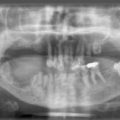Etiological factors
Thyroid cancer shows two age-related peaks of incidence, one before the age of 40 and one after 60. The condition is approximately three times as common in women than men. Exposure to ionizing radiation in childhood, either therapeutic, such as radiotherapy for Hodgkin’s disease, or associated with environmental exposure, increases the risk of developing thyroid cancer. There is, however, no proven relationship between the development of thyroid cancer and administration of iodine-131 for the treatment of hyperthyroidism.
Other medical conditions which affect the thyroid have also been linked with an increased risk in developing thyroid cancer, namely, endemic goiter, which occurs in areas where there is low natural iodine, Hashimoto’s thyroiditis, a past history of thyroid adenoma or a family history of thyroid adenoma or cancer. Some genetic conditions which increase the risk of thyroid cancer include Gardener syndrome, Cowden’s syndrome, familial adenomatous polyposis and the multiple endocrine neoplasia syndromes.
Thyroid cancer initiation and progression is supposed to be through accumulation of genetic and epigenetic events. It point mutations of BRAF (Predominantly Papillary) and RAS (N,H,K-Ras Predominantly Follicular) genes and Chromosomal rearrangements-RET/PTC-(Papillary particularly radiation induced), PAX8/PPARγ (Follicular); abnormal miRNAs’ (microRNA) with gene methylation problems also play its part. All these are now being detected on Fine needle aspiration cytology. This will avoid diagnostic lobectomies for indeterminate and benign nodules in the future protecting patients from unnecessary surgery as well as allowing one-stage total thyroidectomy for cancer patients (instead of lobectomy followed by total thyroidectomy in Thy3 cases) and saving costs. P53 mutations are thought to be a late event in progression from differentiated to Anaplstic thyroid cancer in a high proportion of cases.
Stay updated, free articles. Join our Telegram channel

Full access? Get Clinical Tree




